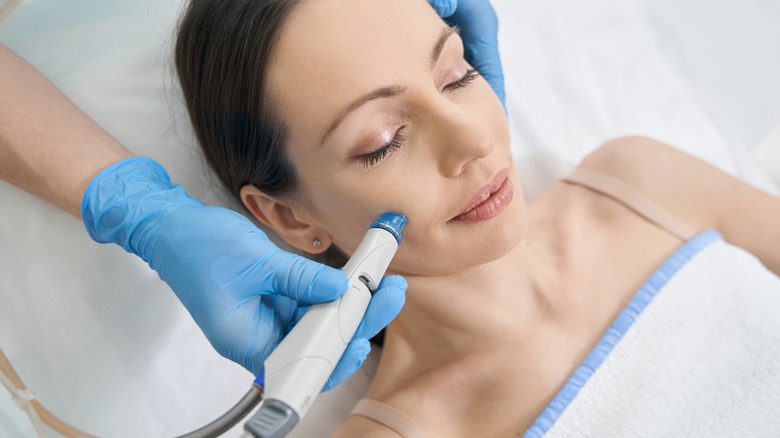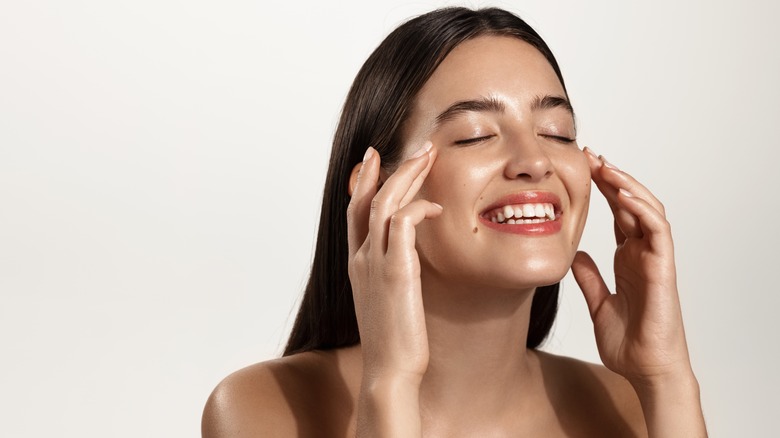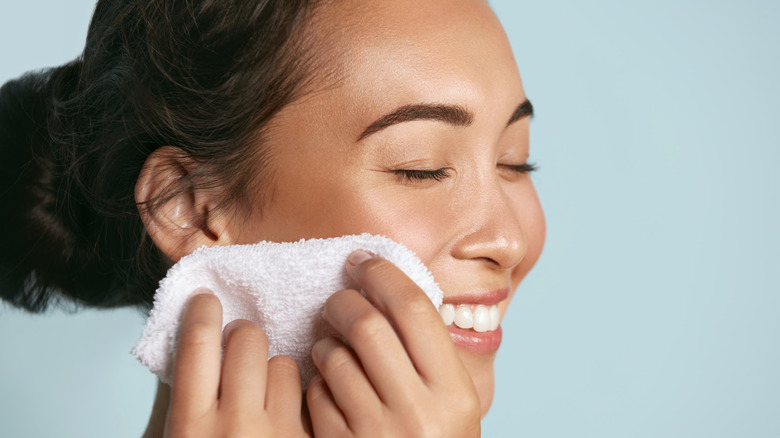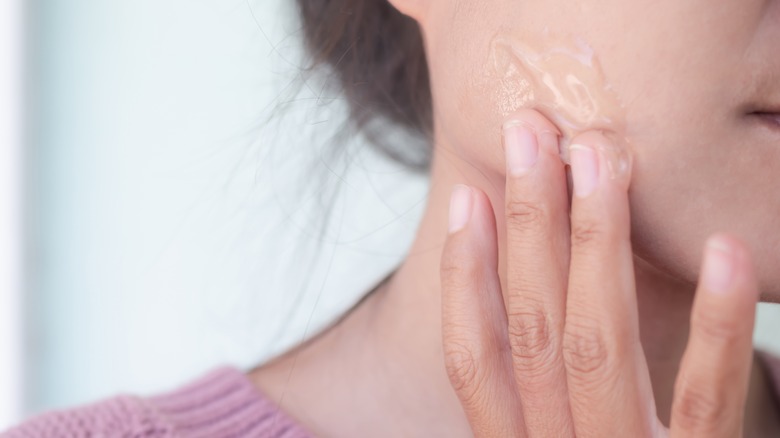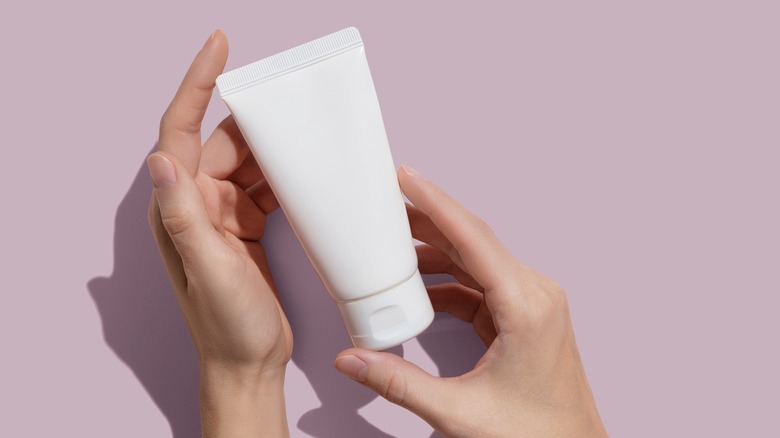What To Know About K-Beauty Staple Water Peels
It's no secret that K-beauty brands helped shape many of the skincare standards we know and love today. Countless holy grail products, from sheet masks to hydrocolloid acne dots, originated in Korea. Furthermore, while matte faces were once in fashion, K-beauty trends influenced the widespread desire for super-hydrated glass skin. "In Korea, skincare is not seen as a vanity thing; it's not seen as a high-maintenance thing. It's seen as a way to take care of yourself," Soko Glam co-founder Charlotte Cho tells Byrdie. The 10-step Korean skincare routine, once viewed as excessive by Westerners, paved the way for skincare regimens totaling 30 steps or more. "If I have to take two extra hours in the morning, I'm going to do it," actor Madelaine Petsch told Vogue of her 38-step skincare routine.
Naturally, new skincare trends are always evolving, and skin-obsessed fans follow the developments of K-beauty products closely. One dermatological phenomenon making waves with K-beauty fans is the water peel. Water peels, or aqua peels, are hugely popular treatments in Korea, and nowadays, they're springing up everywhere. But what is a water peel, and how can it benefit your skin?
The origins of Korean water peels
The concept of water peels originated in Korean cosmetic clinics. Skincare practitioners begin the water peel by exfoliating the skin with a suction tool, which simultaneously clears pores and delivers a gentle enzyme treatment. After the skin is prepped, the practitioner uses a skincare device to "push" a hydrating product, like hyaluronic acid, into the skin. In the West, many beauty spas offer HydraFacials, which follow a very similar multi-step process.
Due to the success of these clinical treatments, K-beauty brands invented water peel products, often referred to as peeling gels, intended for at-home use. Over-the-counter products aren't quite like the real thing, but they contain exfoliating enzymes and hydrating ingredients to mimic the water peel process. Some skincare enthusiasts use at-home water peels alongside tools or devices to replicate the spa experience. "Without having to step outside, you can tailor your needs at home with LED masks, galvanic massagers, or water peeling facials," Oh My Gloss founder Sarah Oh tells Glamour. With frequent use, water peels can help increase product absorption and improve skin hydration.
How K-beauty water peels promote healthy skin
Water peels have numerous benefits for your skin, starting with their exfoliating properties. "By combining the naturally exfoliating power of water with hydrating hyaluronic acid and botanicals, aqua peels slough off dead cells without using harsh acids," Dr. Maryam Zamani tells Net-a-Porter.
K-beauty typically emphasizes chemical exfoliation rather than physical scrubs, and water peels are no different in this regard. Although the skin is capable of shedding dead cells on its own, chemical exfoliation is useful for speeding up cell turnover and reducing blemishes with ease. Clinical water peels also use suction power for manual exfoliation, but at-home products rely on gentle peeling ingredients like AHAs, BHAs, and PHAs.
Of course, water peels are also revered for their hydrating effects. Water peels often include ingredients like aloe vera, hyaluronic acid, and peptides to provide long-lasting moisture for your skin. With regular use, water peels can improve skin texture and elasticity, giving you a clear, healthy-looking complexion.
Who can benefit from using water peels?
Every water peel product is different, and spa treatments can vary from clinic to clinic. However, most people can use water peels in their skincare regimen. Many K-beauty products, including water peels, are designed to be used as needed to protect sensitive skin. Still, those who are allergic to common peeling ingredients, such as chemical exfoliants or fruit enzymes, should avoid using water peels entirely. If you're unsure whether to incorporate a water peel product into your routine, it's always advisable to perform a patch test first.
Furthermore, specific components of water peels, like chemical exfoliants, should never be mixed with other products. "Be careful combining various acids or even physical and chemical exfoliants, as this can lead to irritation and even eczema," Dr. Shari Marchbein tells InStyle. Other ingredients that may interact with water peels include acne-fighting actives such as salicylic acid and benzoyl peroxide.
Which water peels are best to use?
If you're looking to try a clinical water peel treatment, your best bet is to look for a HydraFacial practitioner, as finding an authentic Korean water peel can be challenging outside of Korea (though this doesn't mean you couldn't try to find one first). When choosing a water peel to use at home, look for products that are tried and tested by skincare reviewers.
There are several at-home water peels available that cater to a variety of skin types. One of the most popular aqua peel products you can use is Saturday Skin's Rub-A-Dub Refining Peel Gel. The Korean exfoliator uses fruit enzymes from papaya and pineapple to sweep away impurities and leaves skin feeling hydrated with its signature peptide blend. "The amount of dead skin that comes off is incredible. However, it exfoliates without leaving my face feeling raw. My skin is smooth and glowing after using it," one reviewer writes.
Sensitive skin users can benefit from specially formulated water peels, like CosRx's Low pH Goodnight Soft Peeling Gel. It's gentle on the skin but delivers powerful results thanks to hard-working ingredients like rice ferment, niacinamide, and hyaluronic acid.
Ways to incorporate water peels into your routine
Wondering how to add water peels to your skincare regimen? Like other exfoliating products, you can use at-home water peel treatments one to three times weekly, depending on your skin's response. "Skin is different every day, and instead of boxing yourself into a set skin type, it's so important to listen to our skin and treat that day's concerns with the right products," Glow Recipe co-founder Sarah Lee tells Vogue. Of course, you should exercise caution when introducing any exfoliating product, chemical or otherwise, in conjunction with other peeling agents like retinol. Combining several exfoliating products at once can damage the skin barrier, but your dermatologist or esthetician can help guide you on how to incorporate multiple exfoliants safely.
Once you've found a favorite water peel, you can experiment with its placement in your routine. Some water peel users enjoy using the exfoliating treatments before applying sheet masks or serums, while others include them as part of their nightly cleansing ritual.

